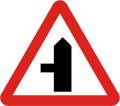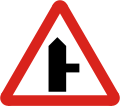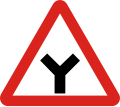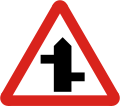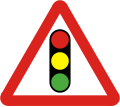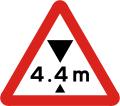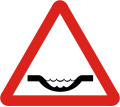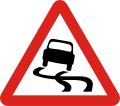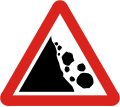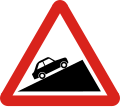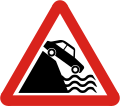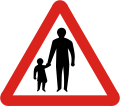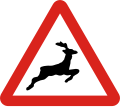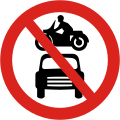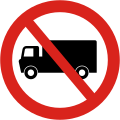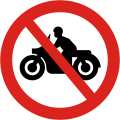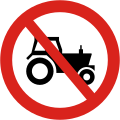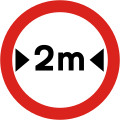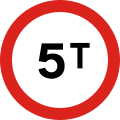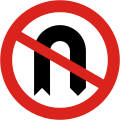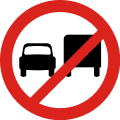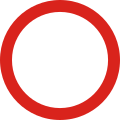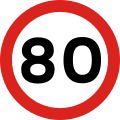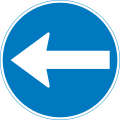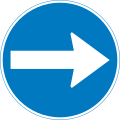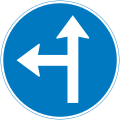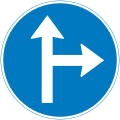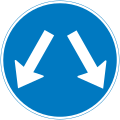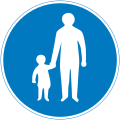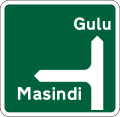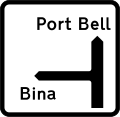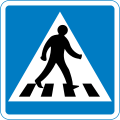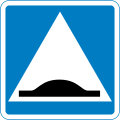Road signs in Uganda are regulated in the Traffic Signs Manual [1] and governed by the Ministry of Works and Transport (formerly the Ministry of Works, Housing and Communications). [2] They closely resemble road signs used in the United Kingdom since Uganda was a British colony until 1962, with the exception that Uganda uses metric system units instead of the Imperial System of units ( miles and yards). [3]
Road signs in Uganda generally use the same pattern of colors, shapes, and symbols set out in the Vienna Convention on Road Signs and Signals, which are also used in most countries of Europe and Africa (except Ireland and Liberia which they both use diamond MUTCD warning signs instead of triangular). Partner states of the East African Community take measures to ratify or accede to international conventions on road traffic and road signs and signals. [4] On August 23, 2022, Uganda acceded to the Convention. [5] Other partner states of the East African Community such as Burundi, Kenya, Rwanda, South Sudan and Tanzania have yet to ratify or accede to the Convention. Uganda drives on the left.
Warning signs
Permanent warning signs
-
Hairpin curve
-
Hairpin curve
-
Crossroad
-
Side road
-
Side road
-
T-intersection
-
Y-intersection
-
Staggered intersection
-
Staggered intersection
-
Roundabout ahead
-
Traffic signals ahead
-
Two-way traffic
-
Other danger
-
Height restriction
-
Uneven road
-
Hump
-
Drift
-
Narrow bridge
-
Loose gravel
-
Slippery road
-
Falling rocks on left
-
Falling rocks on right
-
Steep descent
-
Steep ascent
-
Quay or river bank
-
Low flying aircraft
-
Crosswinds
-
Railway crossing with gate or barrier
-
Railway crossing without gate or barrier
-
Pedestrian crossing ahead
-
Pedestrians
-
Children
-
Agricultural vehicles
-
Wild animals
Hazard marker signs
-
Long chevron
-
Long chevron
-
Short chevron
-
Short chevron
-
T-intersection chevron
-
Roadside hazard plate
-
Roadside hazard plate
-
Roadway hazard plate
Temporary warning signs
-
Roadworks
-
Barricade (no entry)
-
Traffic control ahead
Regulatory signs
Prohibitory signs
-
No entry
-
No motor vehicles
-
No motor vehicles except motorcycles
-
No trucks
-
No buses
-
No motorcycles
-
No tractors or slow-moving vehicles
-
No bicycles
-
No pedestrians
-
No animal-drawn vehicles
-
Length limit
-
Height limit
-
Width limit
-
Gross weight limit
-
Axle weight limit
-
No left turn
-
No right turn
-
No U-turns
-
No overtaking
-
No overtaking by goods vehicles
-
No parking or waiting
-
No stopping or standing
-
Speed limit (30 km/h)
-
Speed limit (50 km/h)
-
Speed limit (80 km/h)
-
End of speed limit (50 km/h)
-
End of speed limit (80 km/h)
Priority signs
-
Temporary traffic control - STOP
-
Temporary traffic control - GO
Mandatory signs
-
Go straight ahead
-
Turn left
-
Turn right
-
Turn left ahead
-
Turn right ahead
-
Go straight or turn left
-
Go straight or turn right
-
Pass on the left
-
Pass on the right
-
Pass either side
-
Buses only
-
Bicycles only
-
Pedestrians only
Guidance signs
-
Map-type advance direction sign - roundabout - Primary roads.
-
Map-type advance direction sign - roundabout – Other roads.
-
Map-type advance direction sign - crossroad - Primary roads.
-
Map-type advance direction sign - crossroad – Other roads.
-
Map-type advance direction sign – T-intersection - Primary roads.
-
Map-type advance direction sign – T-intersection – Other roads.
-
Stack-type advance direction sign - Primary roads.
-
Stack-type advance direction sign - Other roads.
-
Lane pre-selection sign - Primary roads.
-
Lane pre-selection sign - Other roads.
-
Direction sign - Primary roads
-
Direction sign - Other roads
-
Confirmatory sign - Primary roads
-
Confirmatory sign - Other roads
-
Place identification sign, entry
-
Place identification sign, exit
-
Diversion ahead
-
Diverted traffic
Information signs
-
Hump
-
No through road
-
Parking
-
Bus stop
-
Prioirity over oncoming vehicles
-
One-way traffic on left
-
One-way traffic on right
-
Police control
-
Start of extra lane
-
End of extra lane
-
Hospital
-
First aid
-
Telephone
-
Information
-
Filling station
-
Workshop
-
Refreshments
-
Restaurant
-
Hotel
-
Rest area
-
Camp site
-
Airport
Supplementary plates
-
Distance to hazard or regulation
-
Extension of hazard or regulation
-
Direction in which message applies
-
Direction in which message applies
-
Vehicle category for which message applies – bus
-
Vehicle category for which message applies – truck
-
Vehicle category for which message applies – car
-
Vehicle category for which message applies – motorcycle
-
Variable text message – one line
References
- ^ "Traffic Signs Manual Vol 1 | PDF | Traffic | Road". Scribd. Retrieved 2023-11-06.
- ^ Ochieng, Paul. "Ministry of Works and Transport i Geometric Design Manual PREAMBLE". Ministry of Works and Transport.
- ^ "The National Measurement Systems, Challenges In Uganda - NCSL International". ncsli.org. Retrieved 2023-11-07.
- ^ "TREATY ESTABLISHING THE EAST AFRICAN COMMUNITY" (PDF). mtic.go.ug. Retrieved 2023-11-06.
- ^ "United Nations Treaty Collection". treaties.un.org. Retrieved 2023-11-08.



